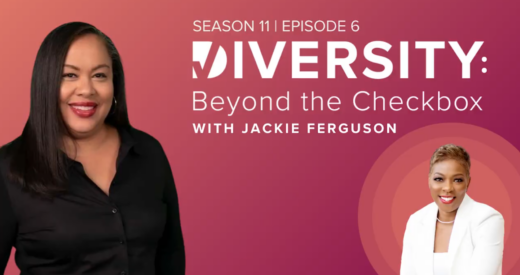The work of diversity, equity, and inclusion (DEI) is business imperative, but how do we begin, or how do we keep up in an ever-changing society? One misunderstanding is that the work of DEI has to be this large-scale, organization-wide, top-down initiative with sweeping changes. It doesn’t. There is so much more that connects us as people than separates us, regardless of race, gender, and sexual orientation. Everyone has a role to play in working to address inequity and increase diversity and inclusion. There are small bites in our communities, workplaces, and personal growth changes that we all can make in order to shift toward a more inclusive and welcoming culture.
I often describe myself as “diversity personified.” I am in an intergenerational, interracial marriage. (My husband is 33 years older than I am.) And together, we are raising both our three-year-old and my sixteen-year-old child from a previous marriage. My father was an African immigrant who came to America as a foreign exchange student where he met my very religious Southern Baptist mother. I am a career-oriented professional. My husband is the primary caregiver in our home. In short, my life contains many dimensions of diversity, only a few of which have to do with my race and gender.
A familiar story for DEI practitioners
In my early career, I certainly didn’t have any clear aspirations to focus on DEI. Yet, one day when I came into work as the Executive Director of Workforce and Talent Attraction for a local Chamber of Commerce, I learned they were in need of someone to focus on strategies around DEI, and that person was now me. I was in shock and a bit frustrated.
I thought, “Why does the black woman have to do diversity work?” And also “Diversity work is hard. Am I being set up for failure?” But soon I realized this new role wasn’t “done to me” but “done for me and my community.” I had the opportunity to lead the way when no one knew which direction to take concerning diverse, equitable, and inclusive organizational outcomes. And I had the chance to not only change my focus on work but also create understanding between hearts and minds, policy and practice.
Small habits build momentum
DEI is more than the way we “say” we do our work. DEI is–and should be–the way that work gets done. It is a part of every facet of every organization, from strategy and recruitment to professional development, succession planning, organizational sustainability, community engagement, and economic impact. It’s not a trend or a buzzword. It’s a tool for creating better business outcomes. Business practices that are grounded in DEI principles are like an insurance policy to ensure relevance, value, marketability, and sustainability for an organization now and in the future.
To start the conversation, I like to ask the question, “How diverse is your universe?” Think about the people that surround you on any given day. How different are they in terms of generation, socioeconomic origin, race, gender, ethnicity, religion, and more? Think about your significant other, coworkers, teachers, mentors, your social circle, and your worship circle, etc. Now, try thinking about your universe differently, taking away those dimensions of diversity. At work, who do you eat lunch with or talk to during breaks? Do you stay within your department, or do you mingle with other people in management, the secretary, the marketing department, the custodial staff, other tenants in the building, etc.? It’s common–and it’s human–that we tend to stay in our bubbles.
Yet the work of DEI means getting outside of our bubbles and thinking differently about our personal universes. When we can get outside ourselves to meet people and experience something different, our workplaces and our cultures grow.
“Language is the road map of a culture. It tells you where its people come from and where they are going.”
I love this quote from Rita Mae Brown because the core of DEI work begins with shared language. What does diversity mean to your organization? What does equity mean? What does inclusion mean? And what other ideas are important to your business in this realm? For instance, you may decide to include justice or access. If we aren’t clear on the words and ideas we want to use, how will we be clear on the solutions?
The benefits of DEI are not imaginary. In fact, they grow more clear and powerful every year.
- Organizations that are taking action to create an inclusive work environment are already achieving 3x the revenue growth of less inclusive organizations.
- Organizations with a DEI culture are more effective in creating a positive employee experience and retaining employees with turnover rates a full 4% lower than organizations that are not taking action.
- Yet, 76% of companies have no DEI goals.
When I share the business case for DEI as part of an organization’s “competitive advantage,” I don’t believe it speaks to any political party or viewpoint that should be polarizing. DEI is a business benefit. Inclusion increases retention, productivity, and your bottom line of profitability. Nothing about respect, dignity, equity, equality, the facts about racism, implicit bias, and other topics should be associated with the divisive and negative rhetoric that seems to be overlaid with those terms.
“Not everything that is faced can be changed, but nothing can be changed until it is faced.” – James Baldwin
Like many of you, I live DEI every day. I can’t escape its presence in my life because I am surrounded by diverse people, backgrounds, and experiences. It’s important that we celebrate, empathize, and recognize the beauty, power, and collective impact we can have when we embrace our differences and use them to our advantage. I can’t snap my fingers to change the visible diversity of a room, but I can help ensure that every room has someone championing this work of DEI, using their influence and DEI expertise to create lasting change.
In sum, the work toward DEI competency cannot be gained through a once-a-year review, special retreat, or one-time training session. This work must become a culture of always learning, of being bold and naming it, of creating expectations for success, of committing to long-term change even if it makes us uncomfortable in the short-term–not only because it helps create a more inclusive society but also because it helps us shift our businesses and organizations to be more productive, profitable, sustainable, and competitive in the market.
Kuma Roberts, IOM, Chief Diversity and Inclusion Officer at Arrowhead Consulting, has over 10 years of organizational development experience specializing in the business case for diversity, equity & inclusion, cultural competence, implicit bias, strategies for becoming an equity-centered organization, inclusive workplace language as well as other elements of diversity, equity, and inclusion. As a graduate of the U.S. Chamber of Commerce Institute of Organizational Management, she has spoken to hundreds of businesses, non-profit, and chambers of commerce on the best practices for developing a strategic plan related to DEI. Kuma is passionate about racial and social justice with an emphasis on shifting policy and practice vs. hearts and minds and speaking to how more companies and organizations can harness the power of DEI to enhance their competitive advantage.






